Donor cultivation is critical to your nonprofit fundraising success. However, a lack of cultivation may be contributing to the industry-wide problem of low donor retention rates.
In fact, according to the Fundraising Effectiveness Project, the average donor retention rate is around 45%. Which means that 55% of donors every year have to be re-acquired.
Clearly there’s an issue that needs to be solved. And from what we’ve discovered in our own research, there’s plenty of opportunity to improve donor cultivation – and lead to more donations and revenue.
With that in mind, donor cultivation is something you should be focused on, if you’re not already.
Let’s dive into what donor cultivation really is…
What is donor cultivation?
Donor cultivation should create a positive emotional and relational connection with your donor by using authentic, humanized communication that provides value and develops trust.
It’s about building a relationship, getting to know them, and allowing them to get to know what you stand for. You wouldn’t ask for a large donation on your first interaction with a prospective donor; you’d build a relationship first. That’s exactly what donor cultivation is – relationship building.
Why is donor cultivation important?
Donor cultivation is a crucial part of gaining more recurring and major donors. Consider donor cultivation as a tool to remind your donors of your cause. It’s meant to keep them in the loop of everything going on with your organization and keep your name fresh in their brain. This helps build trust and has been proven to the likelihood of one-time donors giving again and more generously.
How to measure donor cultivation?
How do you know if you are successfully cultivating and retaining donors? Do you measure it? Well, if you’re not, you should!
Closely tracking and analyzing your Donor Retention Rate will help determine what strategies are working and what aren’t, while helping you better understand your donors.
4 Ways to Cultivate Donors
While there is no secret, 5-step formula to perfectly cultivate your donors, there are a few strategies you might adopt (based on research and proven with data) in order to maximize your relationship with donors.
1. Consistent communication
Communication is key. Not just once, but regularly and consistently. Keeping your donors updated with the latest news, exciting milestones and being transparent about what donations are going towards can help improve donor engagement and retention.
To test this idea that more frequent communication has a positive impact on donor engagement, one organization sent more emails to half of their email file. By creating more consistent communication with these donors, they saw a 41.5% increase in revenue.
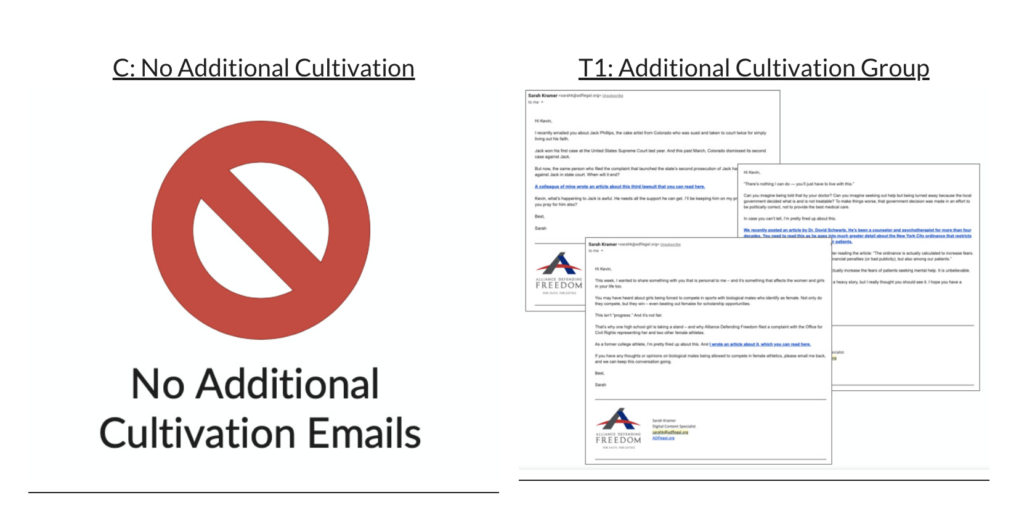
Remember, you most likely aren’t the only organization in their inbox. Sending more emails can help ensure yours get seen, and also create more touch-points with your engaged donors.
2. Personalization
While sending individual emails to every donor would be an effective way of cultivating donors, you don’t have the time or capacity to personally contact every single donor individually.
However, even mass communication with your donors and prospective donors can still be personalized.
One way you can do this is by addressing your donors by name in your emails or your email subject lines. This can easily be done with the personalization features in your email marketing platform.
In fact, here are 3 different experiments where creating a more personal sounding and feeling email led to better performance.
When you clearly communicate the impact of a donation along with adding these personal touches, you’ll create deeper, longer lasting relationships with your donors.
3. Empathy driven fundraising
Staying consistent with communication is key, but research continues to show that empathy is one of the most important tools you have as a fundraisers.
If we can’t put ourselves in the shoes of our donors and communicate in a way that is relevant, it can undermine all of your donor cultivation efforts.
And empathetic donor cultivations starts first with communicating like a real human being,
One way to start communicating more like an empathetic human being is to make your emails look something like your donor would receive from a friend – no design and a conversational tone.
Just by switching their email design to a plain-text style, this organization saw a 112.5% increase in donations and an 80.3% increase in clicks.
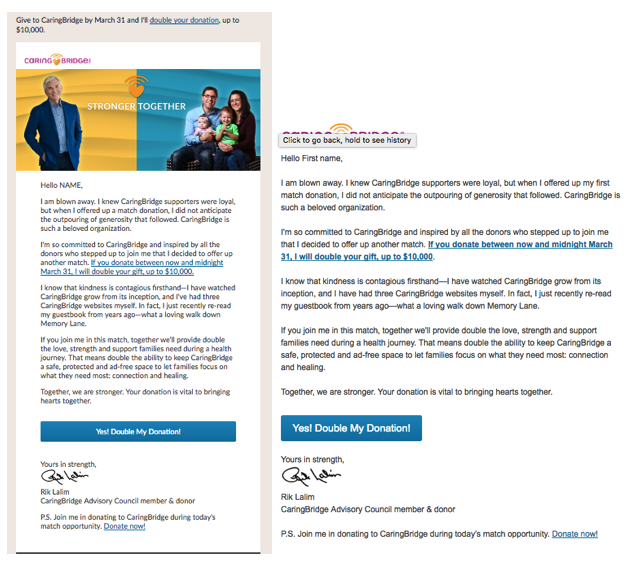
By stripping their email down to a plain-text format and writing copy with a personal, conversational tone, another organization saw a 28% increase in response.
4. Timing is everything
Have you just received a donation from a new donor? Great!
The common fundraising response is that you should quarantine their email address and not ask them for a donation for next 2 to 6 months.
However…some of the common “best practices” around asking for a second donation don’t align with what the data actually says.
In fact, according to The State of Modern Philanthropy report from Classy, your new donors are most likely to give a second donation (or become a recurring donor) within the first 45 days of their first donation.
You should certainly start saying thank you and cultivate your new donors right away. However, you should also be sure to include opportunities for donors to make a second gift in your follow-up communication.
Proven Nonprofit Donor Cultivation Strategies
Let’s dive in a little deeper to uncover three donor cultivation strategies that have been proven to gain donors and increase revenue.
Donor cultivation is something that every fundraiser wants to improve, but when we analyzed the email cultivation practices of 253 nonprofits, we found there are major opportunities for growth.
There are lots of ways that you can cultivate your donors, but which ones are actually proven to work and simple to implement?
With these 3 donor cultivation strategies below, you’ll see real applications and real data, proving they work, so that you can craft a donor cultivation plan that will start to lead to better results.
Strategy #1: Run Some Branded Advertising During Your Welcome Series
Cultivating your donors across different channels is crucial to help your organization cut through the clutter of their inbox and be on the top of their mind when they’re ready to make a gift.
Try running some branded advertising to those in your welcome series to help them learn more about your organization.
You don’t have to send anymore appeals than usual, and you can increase revenue by using this strategy to supplement your existing cultivation.
See how this organization used branded advertising to increase donations by 760%:
How Branded Advertising During a Welcome Series Affects Donation Conversion
In this experiment, the organization was sending a fairly typical welcome series. They sent five emails in the first six days that introduced new subscribers to various aspects of their organization. They wondered if showing branded Facebook ads to the subscribers in the welcome series could lead to an increase in donations.
The control group received the standard welcome series. The treatment group received the same welcome series while also seeing branded advertising on Facebook that provided additional information about the organization.
Research Question
Will branded Facebook ads during a welcome series lead to an increase in donations?
Design
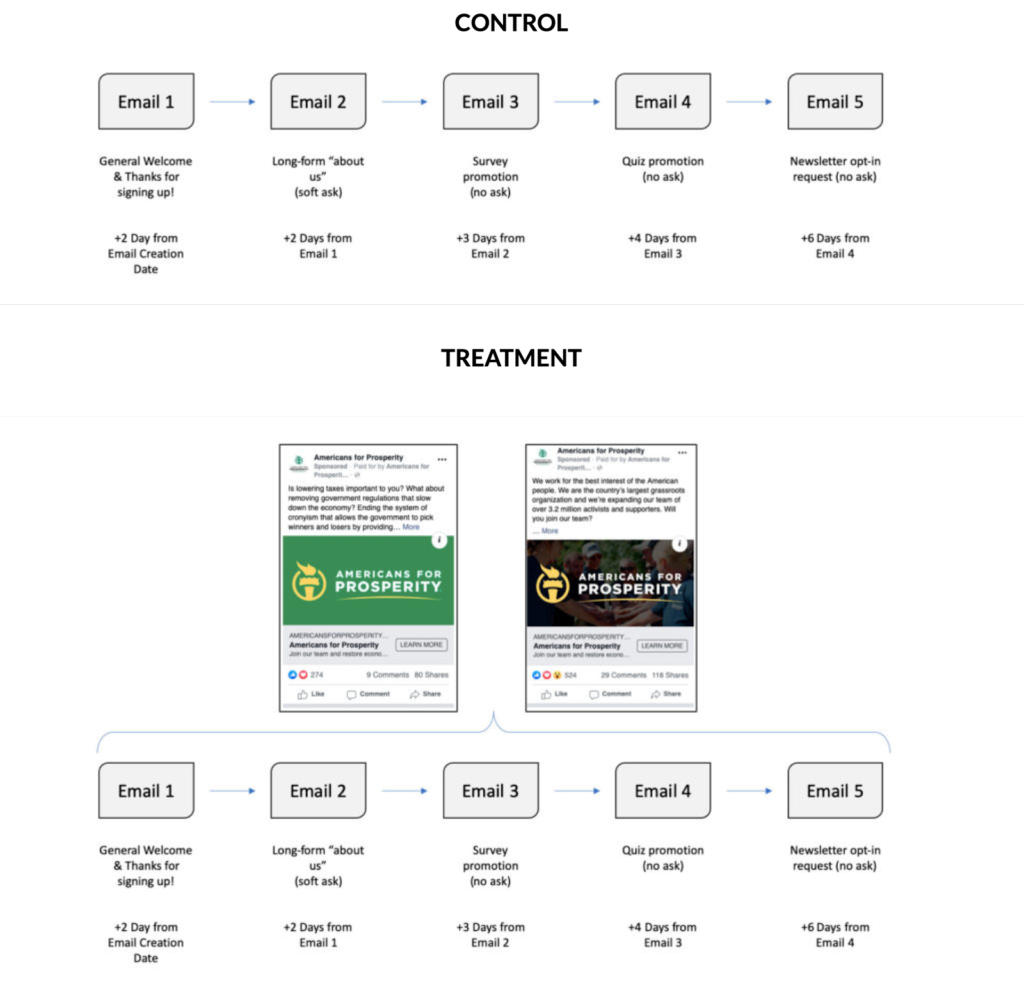
Results
Showing the branded Facebook ads to new subscribers while they were in the welcome series led to a 760% increase in donation conversion rate. It also affected how quickly a new subscriber donated.
On average, it took subscribers who did not see the branded advertising 29 days to donate. Those who saw the advertising took only 17 days on average to donate.
All in all, showing these branded ads to the new subscribers increased both the likelihood that they would donate, as well as how quickly they would donate.
Strategy #2: Redesign Your Emails
Less actually can do so much more when it comes to the design of your cultivation emails.
In order to connect with your donors and target those emotions needed for them to stick around, start thinking about cultivating donors like how you maintain your friendships.
Things need to be personal and human, not overly designed with big logos and stock photos. Because people give to people – not to faceless organizations or marketing machines.
And this strategy actually makes less work for you, so it’s a win for everyone.
So next time you’re crafting a cultivation email, skip the heavy design work.
Here’s what we found when one organization ditched the fancy graphics and sent a more plain-text style email:
How the Design of an Email Impacts Clicks and Donations
In this experiment, the organization started with a designed email that looks similar to many organizations’ default email templates. It used a colored background wrapper, a logo at the top, a large header image, hyperlinked text, an HTML call-to-action button, and a large signature image at the bottom. They wondered if they could actually increase clicks and donations by dropping the HTML template and sending an email that looked less like marketing and more like something a real person would send.
Research Question
Will a less-designed and more personal email lead to more clicks and donations?
Design
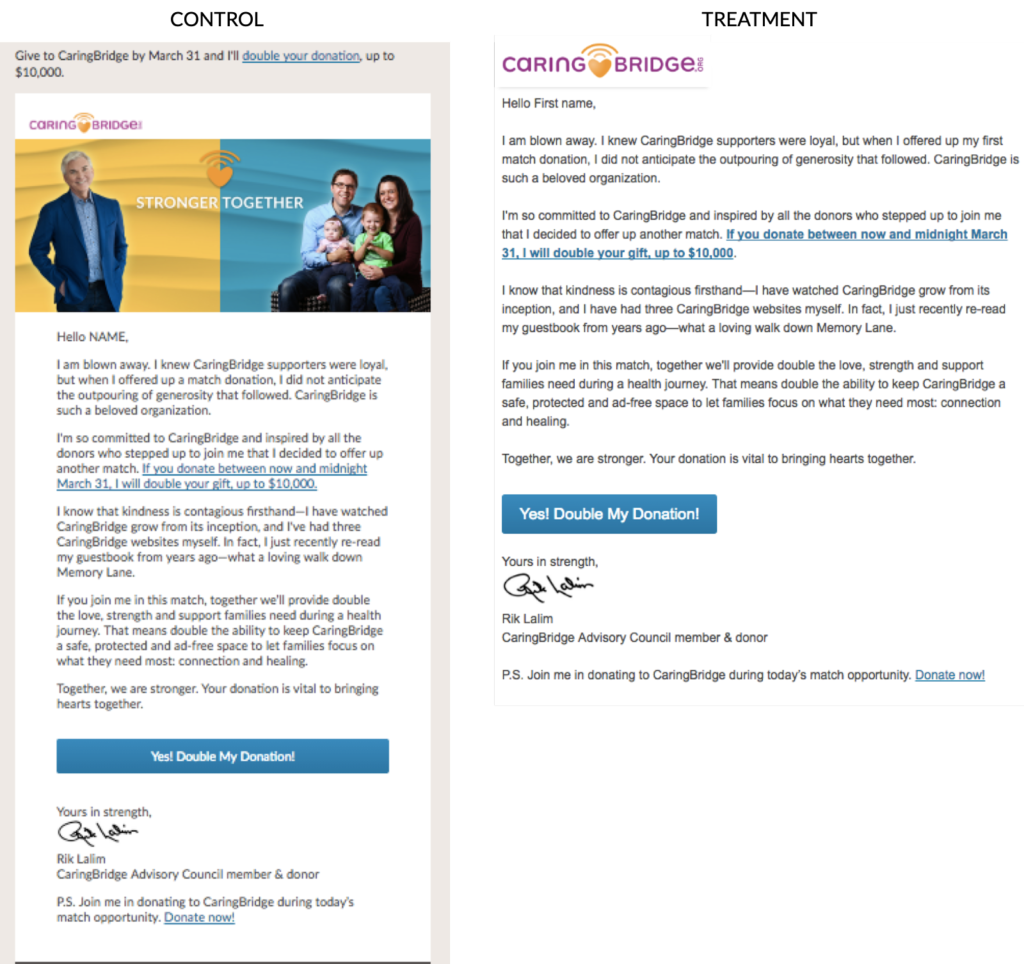
Results
By stripping away significant aspects of the HTML email template, the more personal-looking email saw an 80.3% increase in clicks and a 112.5% increase in donations. Looking at the treatment, there clearly are more “designed” elements that could be removed to make the email more personal in appearance. So this organization launched a new experiment to take the concept one step further.

The new treatment moved the logo from the top of the email down to the signature section. They also eliminated the HTML call-to-action button and replaced it with a text-only link. The tone of the email even changed to make a more personal donation appeal.
This new treatment saw a 145.5% increase in donations.
Strategy #3: Follow-up and Thank Your Donors
Obviously you need to follow up with and thank donors. But did you know that the language you use to say thank you can actually make a substantial impact on how “good” your donors feel?
Check out how regular thank-you communications helped this organization:
How Thank-You Communications Make People Feel Better About Themselves and the Organization They Support
Special Note: The following case study, which won a 2019 Nonprofit Innovation & Optimization Award was done by — and reproduced here with the approval of — The Institute for Sustainable Philanthropy. It can be read in full in the Learning to Say Thank You: The Role of Donor Acknowledgements report which can be found here: philanthropy-institute.org.uk/reports/
In this experiment, the Goodwill of Greater Washington wanted to see if shoppers viewed themselves as part of the larger Goodwill mission and community. They also wanted to see how different types of thank you communications could better connect them with their impact to boost engagement.
After their purchase, three types of thank you emails were sent to shoppers over a few weeks, and their purchasing behavior during those and subsequent weeks was recorded. Four months after the shoppers received their first thank-you email they were sent a survey via email.
Research Question
Will regular thank-you communications better engage supporters?
Design
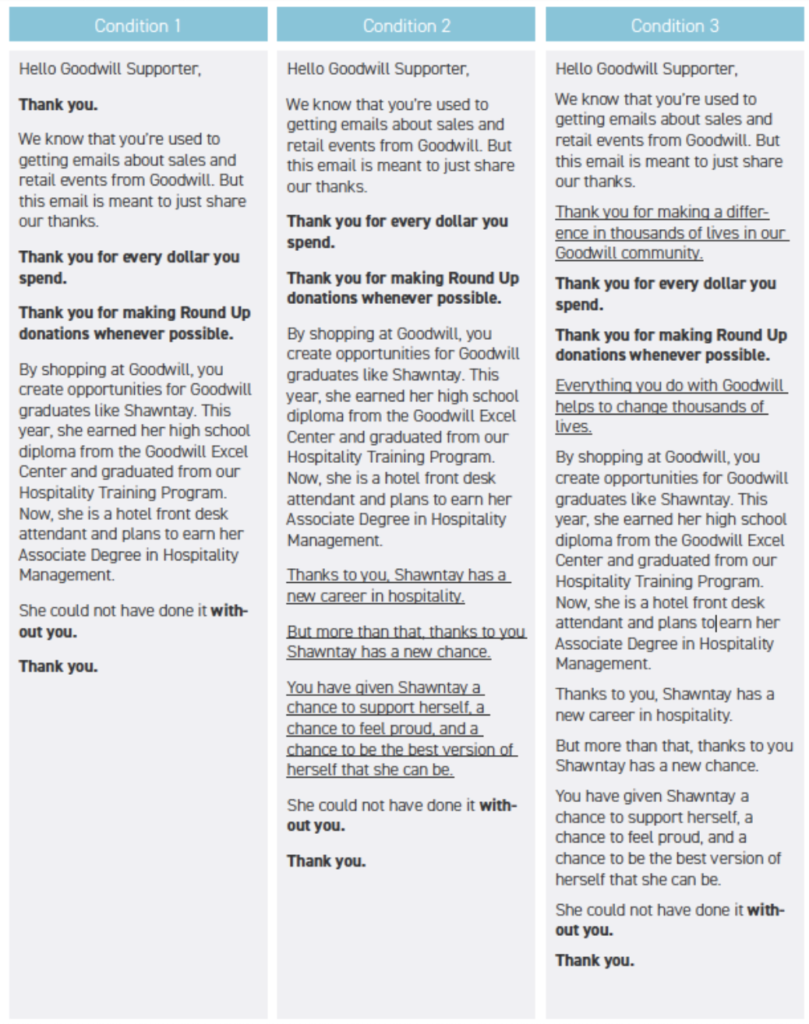
Results
Before even analyzing the data, Goodwill of Greater Washington knew the overall response to the change in acknowledgement style was positive as many shoppers were replying to thank them for the email.
Statistically, thanking people repeatedly for changing beneficiaries’ lives (the shopper condition) had the biggest impact on behavior. Shoppers who received emails in this condition increased the number of purchases they made by 5.8% (a statistically significant result).
Beyond the increased purchasing behavior, the emails in all three conditions increased how ‘good’ people felt not just about themselves but also about the Goodwill of Greater Washington.
Conclusion
Cultivating long-term donor relationships doesn’t have to be complicated. Simple strategies—like branded advertising during a welcome series, using more personal emails, and thoughtful follow-ups—can make a big impact. By focusing on human connection and clear communication, you can increase both donor engagement and donations.
And remember: testing and refining your approach continuously will help build deeper, lasting donor relationships. Keep experimenting, and you’ll see results!




